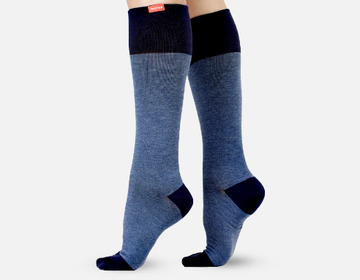
Are you wondering if your Flexible Spending Account (FSA) can cover the cost of compression socks? This article explores the eligibility requirements for using FSA funds to purchase compression socks and offers guidance on claiming them. We'll delve into factors like compression rating, medical necessity, and specific plan limitations.
Are Compression Socks FSA Eligible?
Yes, compression socks can be eligible for FSA reimbursement under certain conditions.
- Compression Level: The socks need to have a compression rating of 30-40 mmHg or higher.
- Medical Purpose: They must be used to treat a medical condition, not for preventative reasons or athletic performance.
If these conditions are met, you can use your FSA funds to cover the cost of compression socks. However, there are some exceptions:
- Limited-Purpose FSA (LPFSA): These won't cover compression socks.
- Dependent Care FSA (DCFSA): These are for dependent care expenses, not medical equipment.
In addition to the above eligibility criteria, here are some further points to consider regarding compression socks and FSA reimbursement.
- Prescription Requirement: Some FSA plans may require a prescription from a healthcare provider to reimburse the cost of compression socks. This prescription typically specifies the medical necessity and the required compression level. Check with your FSA administrator or healthcare provider to see if this applies to your plan.
- Documentation: Keep all receipts and documentation related to your compression socks purchase. This includes the itemized receipt showing the date of purchase, the name of the product, the amount paid, and any prescription details if applicable. Proper documentation is essential for FSA reimbursement and may be requested for verification purposes.
- Fitting and Sizing: Proper fitting and sizing of compression socks are crucial for their effectiveness in managing medical conditions. Some FSA plans may cover the cost of a fitting session with a healthcare provider or certified fitter. This ensures that the compression socks are tailored to your specific needs and medical condition.
- Reimbursement Process: Understand the reimbursement process outlined by your FSA plan. This may involve submitting a claim form along with supporting documentation either online, through a mobile app, or via mail. Familiarize yourself with any deadlines or submission requirements to avoid delays in reimbursement.
- Coverage Limits: Check if there are any coverage limits or restrictions on the reimbursement amount for compression socks within your FSA plan. Some plans may have annual maximums or limitations on the types of medical equipment eligible for reimbursement.
- Flexible Spending Account (FSA) vs. Health Savings Account (HSA): It's important to note that while compression socks may be eligible for reimbursement under an FSA, the rules may differ for Health Savings Accounts (HSAs). HSAs have their own set of eligibility criteria and rules regarding qualified medical expenses. If you have an HSA, verify with your HSA administrator whether compression socks are eligible for reimbursement.
- Other Eligible Expenses: Explore other eligible medical expenses that may be covered by your FSA, such as prescription medications, doctor's visits, medical supplies, and certain medical procedures. Maximizing the use of your FSA funds for qualified expenses can help you save on healthcare costs.
Remember to consult your FSA administrator or healthcare provider for personalized guidance regarding FSA reimbursement and the eligibility of compression socks under your specific plan.
Will My Insurance Cover Compression Socks?
Insurance coverage for compression socks depends on a few factors.
- Medical Diagnosis: Generally, insurance will only cover compression socks if you have a documented medical condition that requires them. This could include varicose veins, lymphedema, blood clots, or other conditions that benefit from improved circulation or reduced swelling.
- Prescription: In many cases, a doctor's prescription is necessary for insurance to cover compression socks. This prescription will specify the compression level needed for your specific condition.
- Insurance Plan Details: Coverage varies greatly between insurance companies and even between different plans within the same company. Your specific plan might have limitations on coverage, such as:
- Compression Level: Some plans may only cover socks with a certain level of compression (like 20-30mmHg or higher).
- Frequency: There might be limits on how often you can be reimbursed for new socks (e.g., every 6 months).
- Supplier Network: Your insurance might require you to purchase the socks from a specific supplier that's in their network.
Here's what you can do to find out for sure:
- Contact Your Insurance Provider: Call the customer service number on your insurance card and ask about coverage for compression socks. They can give you specific details about your plan and what steps you need to take for reimbursement.
- Talk to Your Doctor: If you have a medical condition that might benefit from compression socks, discuss it with your doctor. They can assess your needs and determine if a prescription is appropriate. They might also be familiar with insurance coverage options in your area.
Are Calf Compression Sleeves FSA Eligible?
Yes, calf compression sleeves rated at 30-40 mmHg or above are typically eligible for reimbursement with a Flexible Spending Account (FSA), Health Savings Account (HSA), or Health Reimbursement Arrangement (HRA). These sleeves provide compression similar to compression socks and are often used for the same medical conditions, such as venous insufficiency, deep vein thrombosis (DVT), or lymphedema.
How Do I Claim Compression Socks?
Claiming compression socks depends on whether you're using an FSA/HSA/HRA or private insurance.
FSA/HSA/HRA
Purchase: Buy the compression socks ensuring they meet the minimum compression rating required by your plan (usually 30-40 mmHg or higher). Keep your receipt.
Check Eligibility: Double-check with your FSA/HSA/HRA administrator to confirm compression socks are covered under your plan and understand any limitations (e.g., compression level, frequency of purchase).
Submit Claim: Follow your plan's instructions for submitting claims. This might involve submitting the receipt and a form online or by mail.
Private Insurance
Doctor's Visit: Schedule an appointment with your doctor to discuss your medical condition and if compression socks are necessary.
Prescription (if needed): If your doctor agrees, they will likely write a prescription specifying the compression level needed.
Insurance Check: Contact your insurance provider to confirm coverage for compression socks with a prescription. Ask about any limitations (e.g., supplier network, frequency).
Purchase: Buy the socks from a supplier in your insurance network (if required) and keep the receipt.
Submit Claim: Follow your insurance provider's instructions for submitting claims. This might involve submitting the receipt and the prescription.
Additional Tips
Save Documentation: Keep all receipts and any doctor's prescriptions related to your compression socks for future reference.
FSA/HSA/HRA: Use your FSA/HSA/HRA debit card to pay for the socks if available. This can streamline the reimbursement process.
Contact Information: Have your insurance information and FSA/HSA/HRA administrator contact details readily available when making inquiries.
By following these steps and keeping the necessary documentation, you should be able to claim your compression socks effectively.
Are 20/30 Mmhg Compression Socks FSA Eligible?
No, 20/30 mmHg compression socks are likely not FSA eligible for medical purposes. FSA guidelines typically require a minimum compression rating of 30-40 mmHg or higher for medical purposes. 20/30 mmHg falls below this threshold.
Even though they might not be eligible for FSA, 20/30 mmHg compression socks could still be beneficial for certain situations like mild swelling, aching, or comfort during pregnancy. However, if you require them for a diagnosed medical condition, you'll likely need socks with a higher compression rating (30-40 mmHg or higher) to qualify for FSA reimbursement.
Final Words
Understanding FSA eligibility for compression socks can help you maximize your healthcare savings. Remember, requirements can vary between plans, so consulting your FSA administrator is crucial. This article provides a roadmap for navigating FSA reimbursement, but don't hesitate to reach out to your healthcare provider or insurance company for personalized advice.
Read More:
How to Measure for Compression Socks
How Do Compression Socks Work
Why Do My Legs Ache After Wearing Compression Socks
How to Put On Compression Socks
When to Put on Compression Socks for Flying
Are Flight Socks the Same as Compression Socks







